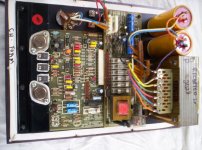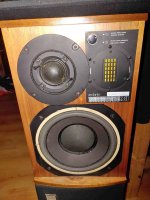I am working on a pair of 3A Andantes Master Control servo controlled, woofer amps, that needed love.
Bought these loudspeaker as "non working amps". Recapped and changed a few cooked resistors and i.c's
. At first, both amps were doing fine but one of them is starting to act weird on my DBT. The bulb glows
longer then all of the amps i've tested; like 3 to 4 seconds before dimming back to normal...
The other amp, behaves normaly, like the normal charging of the main supply caps, on initial turn-on.
The "defective" amp also has a slight buzz in the woofer, while the bulb glows abnormally long. The amp works normal
it seems, after initial turn-on. Those loudspeakers have a auto-turn-on like a modern subwoofer.
I am going to check DC offset and compare the 2 amps on my scope, using a audio generator.
What could cause an abnormaly long DBT glow on turn-on???.
Pulle all the transistors and diode and tested them on my Peak tester, all OK...
Bought these loudspeaker as "non working amps". Recapped and changed a few cooked resistors and i.c's
. At first, both amps were doing fine but one of them is starting to act weird on my DBT. The bulb glows
longer then all of the amps i've tested; like 3 to 4 seconds before dimming back to normal...
The other amp, behaves normaly, like the normal charging of the main supply caps, on initial turn-on.
The "defective" amp also has a slight buzz in the woofer, while the bulb glows abnormally long. The amp works normal
it seems, after initial turn-on. Those loudspeakers have a auto-turn-on like a modern subwoofer.
I am going to check DC offset and compare the 2 amps on my scope, using a audio generator.
What could cause an abnormaly long DBT glow on turn-on???.
Pulle all the transistors and diode and tested them on my Peak tester, all OK...
At first, both amps were doing fine but one of them is starting to act weird on my DBT. The bulb glows
longer then all of the amps i've tested; like 3 to 4 seconds before dimming back to normal...
The other amp, behaves normaly, like the normal charging of the main supply caps, on initial turn-on.
The "defective" amp also has a slight buzz in the woofer, while the bulb glows abnormally long. The amp works normal
it seems, after initial turn-on. Those loudspeakers have a auto-turn-on like a modern subwoofer.
I am going to check DC offset and compare the 2 amps on my scope, using a audio generator.
I've excerpted the most concerning phrase--- it sounds like one amp was working well but then began to act weird, i.e. it deteriorated?
My conjecture is that variation among amplifiers could easily result in differing settling times. An amp with low initial offset at its input differential pair would settle very quickly since there's little error for the servo to correct. An amp with large initial offset will take longer.
Perhaps when the amp is burdened with the DBT it takes longer to reach equilibrium. I imagine these quirks will evident on your scope. If the problematic amp has larger output on its error amp re the other amp, that would be supportive of my pet theory.
Good luck!
TO-3s.
Ouch.
If you find the fault easily, well and good.
The problem with old amps is that the circuits have many components that will need checking and repair / replacement due to ageing.
I would change the electrolytics as well while doing the other service.
If you do not find the fault easily, or it is a complex job, and the drivers are in good condition, think of putting new amps, from what you think is the best choice of plate amp, Class D module, or a chip amp module matching the supply voltage available.
The marking is unclear, those could be very capable TO-3 devices, in that case, my apologies.
Ouch.
If you find the fault easily, well and good.
The problem with old amps is that the circuits have many components that will need checking and repair / replacement due to ageing.
I would change the electrolytics as well while doing the other service.
If you do not find the fault easily, or it is a complex job, and the drivers are in good condition, think of putting new amps, from what you think is the best choice of plate amp, Class D module, or a chip amp module matching the supply voltage available.
The marking is unclear, those could be very capable TO-3 devices, in that case, my apologies.
Last edited:
The outputs are all original 2N3442 's. Tomorrow, i'll hook them up on the scope, and see what i get.
2N3442, 140V, 10A, 117W, Ft = 80kHz, said to be used in audio amps among other applications.
Out of production at the OEM, Multicomp Taiwan does make them, element14 has them available here in India. There could be other makers also.
Please check and compare both amps, should not be difficult to trace, even a bad pot could be the cause.
Out of production at the OEM, Multicomp Taiwan does make them, element14 has them available here in India. There could be other makers also.
Please check and compare both amps, should not be difficult to trace, even a bad pot could be the cause.
If i could find the schematics for these! 🙁 . I have no idea where would be the emiter resistors, to measure the bias. There is a DC Offset pot, clearly identified on the board, and 2 other un-clear pots. One has to do with the servo to woofer calibration.
Thanks Huggygood! but those are the easy ones to find! 🙁 the version i have here are VERY different...
Can you take a pic of the back of the speakers please ?
There are some models that have been made "custom-made" for audio and audiovisual professionals, and the clues are behind them.
There are some models that have been made "custom-made" for audio and audiovisual professionals, and the clues are behind them.
I am not a tech, but i fixed and worked on push-pull amps but this one is new to me. I'm looking for a pair of (or a single), emiter diode to adjust bias. Oh and, i have no clue how many millivolts bias should be!? 🙁

Bias adjustment:
settings on potentiometer R13 (100 ohms)
measures 8mV on terminals 2 and 3 of the "Y" connector.
Setting the midpoint of the power supply (1/2T)
measurement on postive terminal of C9 and adjustment with r11 (220 ohms).
settings on potentiometer R13 (100 ohms)
measures 8mV on terminals 2 and 3 of the "Y" connector.
Setting the midpoint of the power supply (1/2T)
measurement on postive terminal of C9 and adjustment with r11 (220 ohms).
My amp is different, i have: P-101, 102 and P-103... P-101 is DC offset and i did successfully adjust it to nesa zero millivolts. I also adjusted P-103, to match both amps output levels, on my oscilloscope. So; P102 would be my Bias?. It is called " c. Rep" on my amps boards...
Sent you a message Huggygood 🙂 . Tried to adjust Bias: it was reading 0.0 millivolts. As soon as i moved the pot: 2 fuses explodes and the amp is no a short circuit on my DBT 🙁
- Home
- Amplifiers
- Solid State
- DBT glowing a lil longer then usual when turning on a servo amp...


